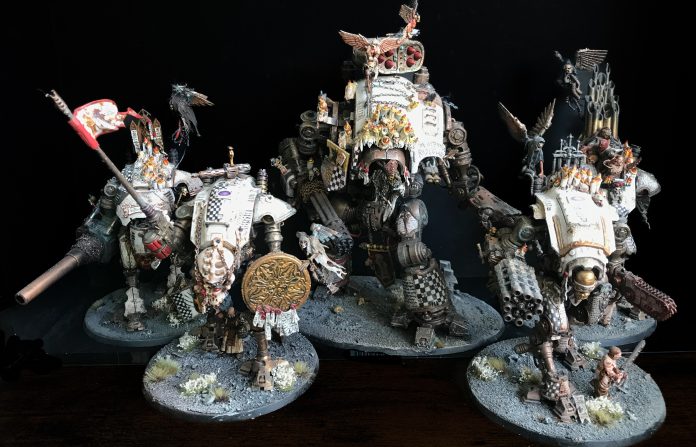Content warning: loss, grief, homophobia
This article started off in one place and ended in a very different one. It was an article about building my Imperial Knight Army, perhaps with a little digression into inspiration and medievalism, and it’s still that. It’s also about grief and memory. It’s how I built, glued and painted an army, but it’s mainly about my Grandfather.
My Knight army was to be a bit of an exploration of medievalisms, what we as gamers – particularly in 40k – take from the medieval period, what elements of medieval Catholicism end up adorning Knights and Space Marines and Sisters of Battle. The major inspiration was Gerald of Wales, a 12th century historian, bishop, credulous legend-believer, general nit-picker and inveterate complainer. He could walk straight off the page and into your collection as an Inquisitor, adept or tech priest – even his nom de plume, Giraldus Cambrensis, could be a spidery scrawl under a Blanche painting, or adorning something from one of the great masters of the Inq28 scene, like our own Skails. He lived his life and quest for preferment as the Bishop of St Davids like a medieval Eldar player, ever hopeful (for plastic aspect warriors), ever disappointed (by the release that never comes).
Gerald’s Journey Through Wales, one of the first, and most nonsensical, travelogues of the British Isles was the basis of many stories I heard as a child. I’d go down south for holidays, and there, I’d learn about Gerald’s journey from a master storyteller. The tales, a mix of natural and cultural history with folklore, myth and legend, fitting seamlessly into our shared worlds of 40k and Age of Sigmar, have become inextricably linked with the man who told them to me. My Grandfather was very much not a 12th century bishop, but a 20th century teacher born and raised in the grinding poverty of between-the-wars. He taught me a lot about history, culture, art, science, how to navigate ceefax, bet on horses, tell when a one armed bandit was about to drop the jackpot, to cheat at cards (and darts, and pool) and when to go all in on a hand of three card brag (whenever you get bored of the game, provided you’re playing for pennies), but most of all he taught me about Gerald.
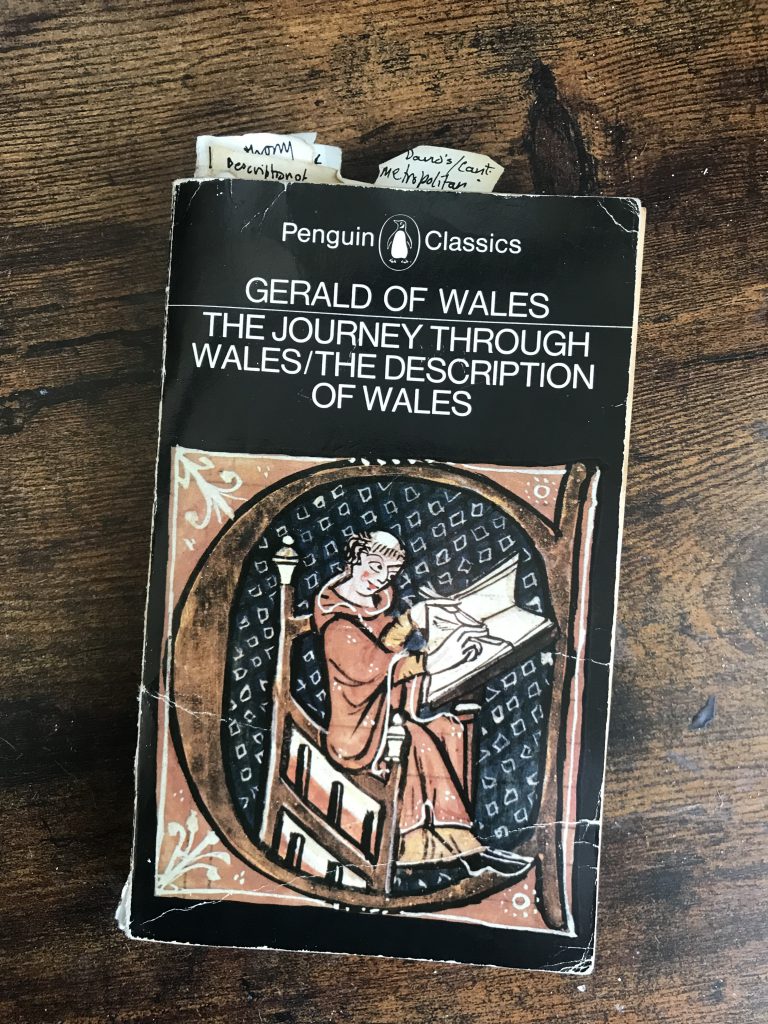 I like to think of both men as friends. Gerald asked the same questions of the world my Grandfather asked, and I have asked after him. These are important, world-changing questions, and medieval Scholars really were concerned about how the stars moved, what a giant would look like after it had lived rough for 200 years, or exactly what metal the wall around hell made of – and what order of demon built it? My grandfather’s annotations add mystery, layering in his half-remembered ideas on theology, the origins of insular art, things he’d heard down the pub once, rural legends from Gloustershire, musings about romanisation and the impact of the second world war on chloral traditions in the south Wales coalfields. Both wrote extensively about the importance, production and administration of candles – the single most essential component of Catholicism. As time passes, the two of them grow ever closer in my mind, and I wonder where one ends and the other began. More pressingly, as my grandfather and I share first names and upon my own transition into bullshit-peddler through the medium of goonhammer and my current experiences of fatherhood, I wonder where I begin, or even if I do begin, in the shadow of the men before me.
I like to think of both men as friends. Gerald asked the same questions of the world my Grandfather asked, and I have asked after him. These are important, world-changing questions, and medieval Scholars really were concerned about how the stars moved, what a giant would look like after it had lived rough for 200 years, or exactly what metal the wall around hell made of – and what order of demon built it? My grandfather’s annotations add mystery, layering in his half-remembered ideas on theology, the origins of insular art, things he’d heard down the pub once, rural legends from Gloustershire, musings about romanisation and the impact of the second world war on chloral traditions in the south Wales coalfields. Both wrote extensively about the importance, production and administration of candles – the single most essential component of Catholicism. As time passes, the two of them grow ever closer in my mind, and I wonder where one ends and the other began. More pressingly, as my grandfather and I share first names and upon my own transition into bullshit-peddler through the medium of goonhammer and my current experiences of fatherhood, I wonder where I begin, or even if I do begin, in the shadow of the men before me.
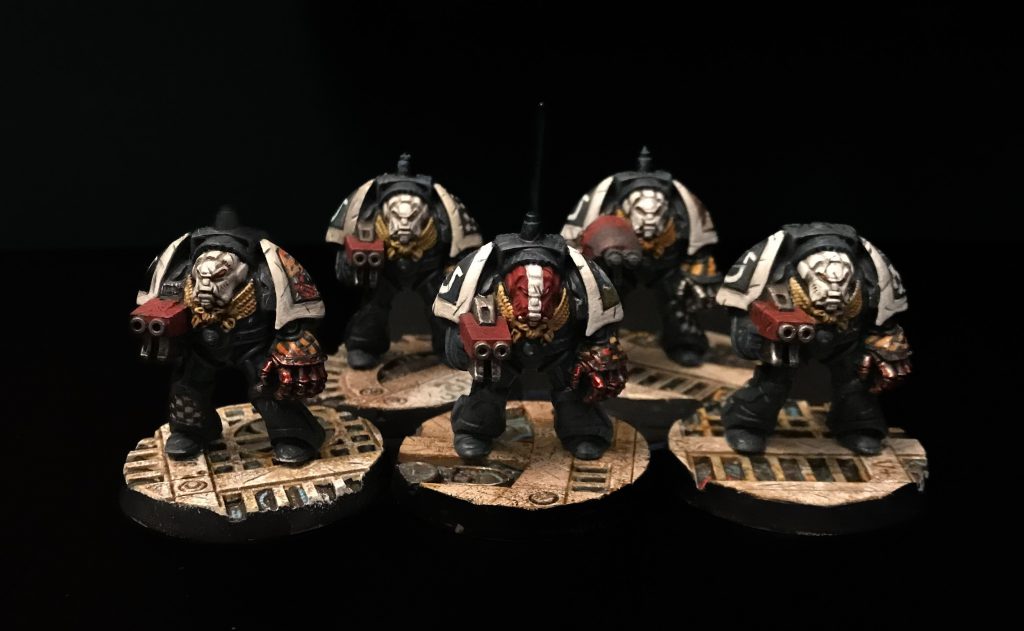
I think we all ended up with some time on our hands to reflect over the last few years, didn’t we? When the pandemic trapped us inside, I became bored. After solo playing three card brag for a while, I took down my copy of Journey Through Wales and opened up a box of Armigers, cleaned all the components and then put them in a box and stared out the window for six months. What stopped me from putting glue to plastic right away was the annotations my Grandfather made in the margins of Journey Through Wales, particularly one right at the beginning, where he’d written “Aaron – remember this”. He must have been writing to himself, but, trapped in a flat too small for two people and a cat, let alone two people, a cat and my memories, I couldn’t find the space to start making Medieval Knights once I’d read it. Aaron, remember this – a question? a command? Nothing to do with me at all? Whatever it was, I couldn’t use Gerald to inspire the Knights anymore and the book – and project – languished untouched.
In October of 2020, as the numbers rose, and members of my family were on death’s door and the floppy haired wanker in charge of the country was doing nothing to stop any of it, in a haze of unbelievable rage I made an Armiger. Six days of sawing the head off a resin monster, smashing it into the carapace, no patience for drying paint or setting times on polystyrene cement, everything done with superglue because if the piece didn’t stick immediately I was going to throw the thing out of the fucking window, slapping paint on with a sponge because my hands were trembling and there was no goddamn hope anymore and everything good had died and – finally – sculpting on a blindfold for the monster’s head because clearly justice was indeed blind, or it would have come for the man on the telly, and it was done. Of course, it was named “Sorrow”. I returned to it a week later to add a servitorised nighthaunt, a reaper, the looming spectre of our shared trauma holding on with a single, rotted, hand to the rock solidity and moral certainty of a giant kill-machine, and a Repentia, holding justice. It is crude, outdated weaponry and medical instrumentation – black powder and chainsaw – being applied to the modern world, for the purposes of dealing death.
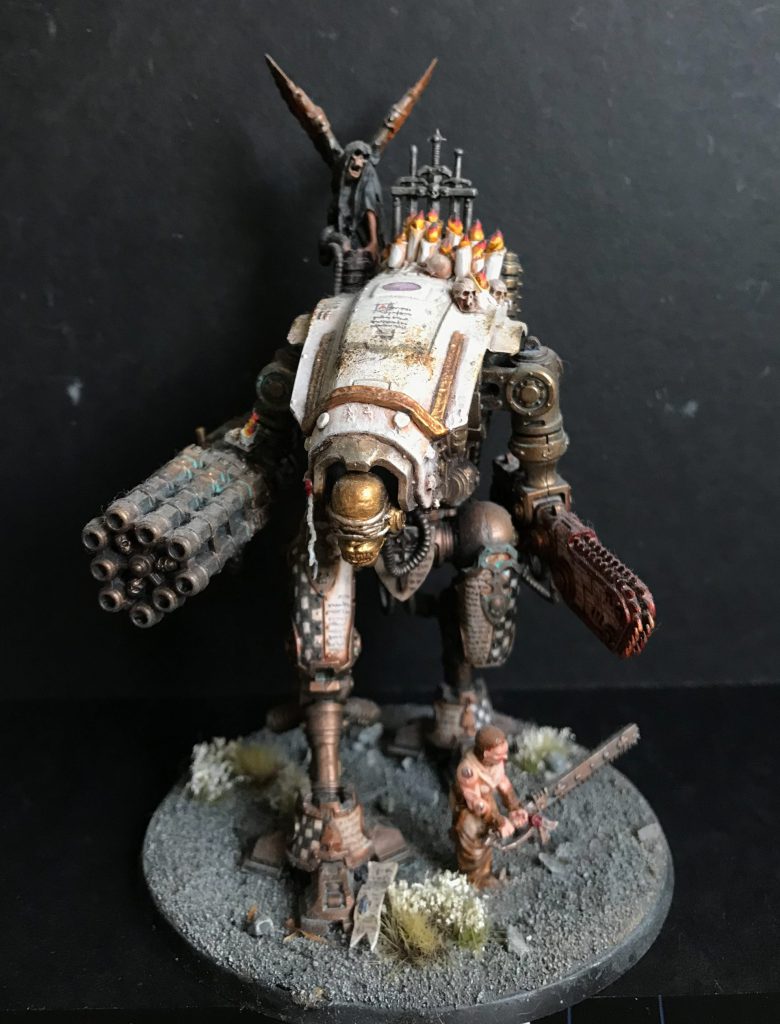
All the little tics and spasms of how I control and channel stress are there for me to see. Precise patterns of freehand scriptwork and chequerboard markings. Laboriously built up layer after layer of greenstuff and candle. White on black. Chains, purity seals and dust. Those details are me controlling feelings I then couldn’t even address or acknowledge, let alone deal with. They’re me exerting an icy control over myself and the model. There are no blends, because blends require and reward artistry and patience. There are washes, applied sloppily and carelessly in layers that were never allowed to dry. Every colour has had the saturation turned down. It’s largely stark black and white straight from the bottle. No paint was thinned. No mould lines carefully trimmed away. These became my way of painting the knights, though later through choice rather than compulsion.
Sorrow was rage and fear. But you fear long enough and you start to feel – and then hear – different. The Rugby came back in October and November 2020, and out of that came hope, in the form of a song. It’s a stereotype that Welsh people are good at singing. I’m crap. My grandfather had a terrible singing voice. The times I heard him sing, it was in a religious context (Rugby) or in a substantially less important religious context (Mass). There’s nothing, nothing, in the world quite like a full to capacity Millennium Stadium belting out Bread of Heaven, because it’s sound you don’t just feel in your bones, your ancestors feel it too. Somewhere out there, every time 74,000 people hit the extended note of Feed me till I want no more (want no more), untold generations of short, dark haired, much-maligned, long-colonised bones rattle, just a little. We didn’t have that in 2020 and 2021, with games played in silence, but I was singing, and I could feel everyone else singing too. Our nation and our language may have been crushed since Gerald’s day, but when the song is raised, when the organ in a tabernacle church gets pumped up and the wide, big pipes start to sound, I mean, fuck me man. No wonder we’re still here.
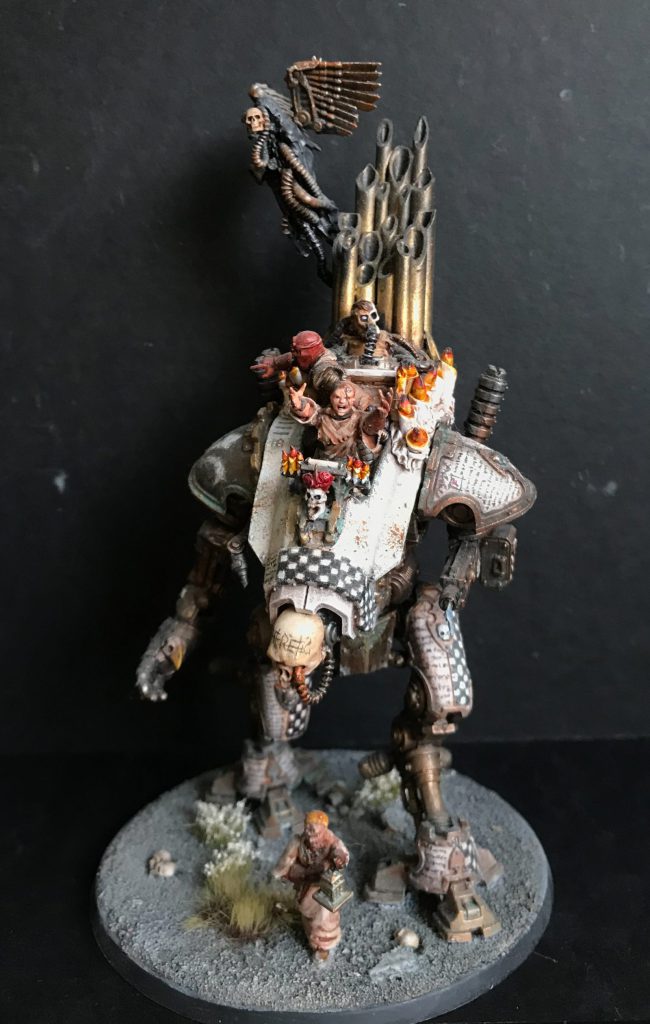
The Penitent was made to the sound of that music, to memories of not knowing the words, and of my saesneg father mocking us, to every tin and clapboard church that wasn’t playing when we were out there getting murdered in 2020 and then the year when we kicked the shit out of the English in silence. The organ pipes are preposterously large, the weight of them pushing down into the body of the model which provides the bedrock for literally soaring music. Everything is uplifted in the service of the sound – the pilots (constructed from Sisters of Battle and Anvil industry bits) have hands thrown into the air, and exhort us to join in with a pointed finger. The servitor-reaper stands tall and proud, carrying – but not wearing – the bones of my ancestors in a high place of honour as it repeats and amplifies their music. I intended it as a hopeful little wraith, the transmutation of death into ancestry. If Sorrow was about rage, the strange zombie-powered pipe organ was hope, joy, and the sound of his voice. It strides forward, screaming forth a song, the Repentia literally carrying the torch, because by that point I’d run out of metaphors.
When my Grandfather died, my mother collected our recollections for his eulogy. If you’ve read this far you can probably tell the tone, content and, indeed, grammatical structure, of what I produced in response. He had been, at times, my shield against the world, and at others, a great and shining spear for labour rights and justice and equality, and it was this that I moved towards when building the Hero. I was envisioning a paragon among knights, a great warrior bedecked in Gold and fluttering pennants, all the trappings of Gerald’s Knights and of Arthur and the Round Table, another story learned at his knee. I wanted an armiger that would take on the most monstrous forces of capitalism, or tyranids, because let’s be honest, they’re exactly the same, and pierce through a black and bloody heart with a single, final blow.

He died long before any of these models were made, and I didn’t really get to talk about any of this – well, he might not have understood much about the models – with him. I didn’t even get to say goodbye to him, just to the last tiny remnant of what remained. Alzheimers is a hell of a disease, so my goodbyes were made to a shell that looked horrifically like a man I had once known. The Hero armiger changed as I made it, both legs first broken at the knee in order to pose sprinting into the charge locked down with chains to make it static. The carapace cut open and an empty throne installed, a hunched pilot resting one hand on its leg, just as I did the very last time. Even the servitor-reaper here is furtive, caught in the act and frozen but – when you look away – it will steal that shield and carry it across into the underworld of my people, Annwn. The candles are extinguished and the whole monstrous edifice of it, with spear and shield in hand as if, at a glance, it is capable of one last fight, is still and hollow, pennants fluttering in the breeze.
As I’ve attempted to shift that particular memory of my grandfather, I’ve had to interrogate what I knew and what I came to know after his death, and the final Armiger was made in the heat of that process. Like many men of his time, of all times, he had opinions we would not be comfortable with today – and should never have accepted or excused then, either. Gerald believed, and repeated, a lot of weird shit about Irish and Welsh people being racially inferior to the Normans. My Grandfather was homophobic. It feels somehow traitorous to write about it, to put it out in a public sphere and not to make excuses of age, or era, or dementia, or whatever, but it is, was, and always will be, inexcusable. I was never exposed to it – why would I have been, I’m straight, and it never came up in conversation, perhaps because I never wanted it to – and by the time I knew and loved my queer comrades, the time had long passed that I talked to him at any significant length. The Bulwark is the last of these I constructed, and perhaps the last Armiger I will ever do, now that the writing of this article has revealed each of them as they were to me in the making.
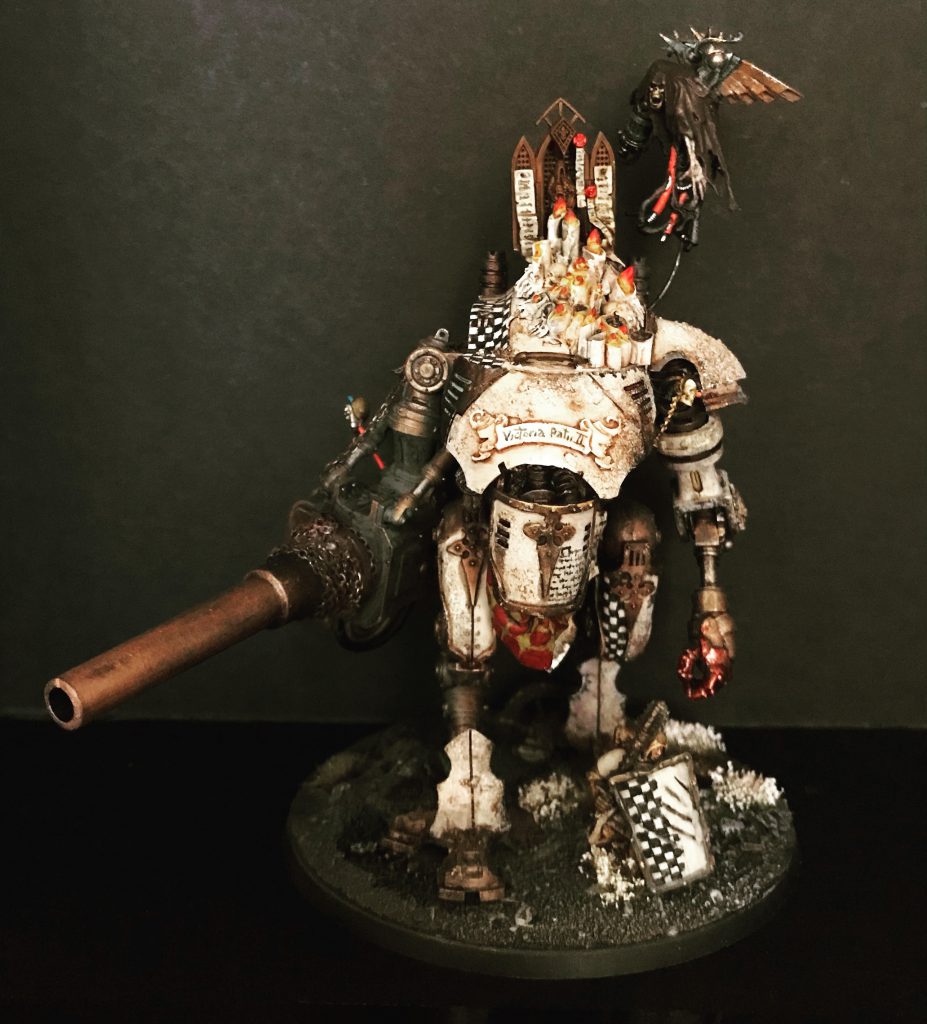
The Bulwark’s pose is hunched and threatening. He is immovable, implacable, unbending. He can stride into the world around him and remain unchanged, for good or ill. His hand is bloodstained and the fingers curl, his weapon charred from use. The reaper stares down at us with disdain, because the opinion, and its aim, is fixed, and the knight itself is blind and cannot see. The repentia this time is armed with baton and shield, the weapons of the state that have been deployed to crush LGBTQ communities. It’s by far the largest of the Armigers, but feels smaller – hunched in on itself and crushed by armour plating. It is a thing that, when we shine the right light upon it, can be removed from the board. It is not what it should be, or what it could be. It is far worse than my grandfather deserves, I believe, an expression of my fear, of my issues, not of the man, and so on its back, we have my contribution to the eulogy, enshrined and encrusted with candles burning in this newly conflicted memory and shame at my failure to engage, to challenge, to correct. Perhaps if I had I would feel less guilt, perhaps I could even have changed his mind.
In writing this – and particularly in seeking feedback from my family – my memory (and the build of the Armiger) has been further called into question, to reveal a man who was challenged, who was slowly changing, whose opinions were born of ignorance, and were rising to where they should have been all along. There’s a chance that, over time, my reasons for building the Bulwark will change, and I’ll justify all those choices in a new way.

I can think of exactly when, and where, we could have discussed this – the exact table over which we’d have had it out, where new understandings would have dawned and different attitudes adopted, and that place is within my Knight Warden. I don’t think I stopped for a moment to think about my big knight until the skeleton was done and it was time for actually making the bloody thing. During the interminable lockdown we endured in early 2021 the project drifted through lack of inspiration. It was a numbing time, one where I struggled to do, say, or think anything at all, let alone put the thought into what I knew would have to be an epic project. The legs and frame of the knight sat on the living room table for a while, mocking me in my attempts to work from home productively, always bloody there and needing something to kick me up the arse to get around to it. What did, in the end, was the experience of heading back out to the pub. At the time I lived round the corner from a crap pub (well, I still do, it’s just round more corners), but it was a blessing to be there, with table service and muted music and outdoor seating and masks on to go for a piss. I’d navigated a long, socially-distanced queue to the toilet and was musing on how covid regs meant that urinal etiquette was now essentially enshrined in law when the absolutely rancid reek of poorly maintained, dripping, urinal troughs transported me back ten years.

When I went to University my grandfather was bursting with pride over every element of that choice – that I’d gone, where I’d gone, what I studied and that he’d impacted all those decisions. I immersed myself in study and didn’t call and didn’t communicate and felt very lost, and it was only much later that I found a real home there. Home, for a while, was a pub. It was a pub covered in pub shit – pictures and quotes and the maltese falcon – a pub with its own idiosyncratic approach to opening hours and layout, with far too many seats crammed into a tiny, cosy space. It was dusty, loud, dripping with sweat when the hash was in, cluttered with memorabilia the meaning of which had long since passed beyond mortal ken. It had its own cricket and rowing teams, both utterly and completely dogshit because it wasn’t a place for “sports”, but a place for sportsmen and women, the kind who knew what WG Grace’s batting average was, but couldn’t tell you a bloody thing about who was playing this weekend and would happily discuss their research and their academic interests until even the lockin had come to an end. It was a place I spent many, many hours over the years I was at University, and one where I frequently thought about my Grandfather and how much he would have enjoyed being there, the ambience, the people, in his prime. I can see him still, sitting in his chair, a little plaque above it, pontificating on anything and everything, engaging in the most delightful of pursuits – pub chat – with me, my friends, and the cast of Withnail and I style characters who formed the regulars, and perhaps Gerald. He’d have his own chair too, of course.

The Big Knight became the spirit of the pub – the Penitential Radegund. It wears the crest proudly and is festooned with candles and pigeons, servo-skulls and pennants. It pictures the saint herself, and suitably grimdark versions of myself and my friend – long-suffering barmaid of the Radegund – in discussion over some point of music or culture. The chequerboard that was originally a method of channelling feelings I felt I had no space for is now a chess board, something to represent many happy hours spent playing games – not, however, playing chess. Sections of the decor were repeated on the carapace and, like all my other knights, the whole thing is lit by candlelight as it is when I remember it, for all that the Rad had normal lights too. The knight looms large in my memory, just like the place.
I never took Him there. I left before inviting him to share this home I’d found, before he could come and have his own opinion of it. The pub shut not long after for a refurbishment, and reopened a strange and soulless place even – god forbid – with a television, before shutting completely. Initially, the knight had a head, but it didn’t seem fitting, because you don’t lead a pub – you sit in one. What it needed was a pilot, so I built Gerald – complete with bishop’s hat – suspended in a state of revenancy, neither dead nor alive, immutable in memory and held in place. He is unable to leave until I allow him to – unable to move on to death, or return to life, because I have transfixed him to the pub, to the memory and to the regret. The Radegund Knight strides forward into the future, but ponderously. It neither walks with vigor or stands stock still. The others crowd around it, but it is not a heroic figure. I love it, but I see every error and every improvement that I could make. I wish I’d brought my Grandfather to the pub, sat with him and discussed Gerald, or anything, or how I felt to know that he was proud of me – but I didn’t, so the Knight is my only way of connecting all these threads. Perhaps the pub will come back – it certainly looks like it might – but the opportunity to take him there won’t, and that’s the spirit I’ve tried to create with the knight. Powerful, important, significant, but still mournful for opportunities I didn’t take, that I still thought I would have time for right up until time ran out.

It’s been a long time since my Grandfather died, and a long time since I touched the Knights. They’re there on the shelf behind my computer and draw a lot of vague compliments when I forget to blur my zoom background on work calls, or when important goonhammer business puts me in the same google chat room as the bosses here. Under them, tucked below a stack of Dreamcast games and a tumble of ammonites, is my grandfather’s copy of Gerald’s writing. The scraps of newspaper used as bookmarks are still there, purposelessly yellowing and mouldering with age. I haven’t read it for a long time now, just as I’ve not brought the knights to a game, and really, for the first time, I understand why. Perhaps there’s hope in the future as I realise why I made them, and what I made them to do. Perhaps, I’ll pick up the book again and read those annotations and try to think more positively about Gerald and myself and process a little more grief. When I can do that, I’ll be able pack up my knights and get them on a table, doing what they were born to do. For now, they gather dust. Out on the horizon though there’s another hulking shape, and another of my Grandfather’s tales that he maintained, life-long, he’d come up with, one of an axe and a knight, and a single blazing colour, of britishness, magic and promises, so this year – eight years of grief later – there is another route to tell a story of the three of us, and another step on the road to easier memories.
Comments, Questions, Suggestions? Get in touch via the comments below or contact@goonhammer.com
